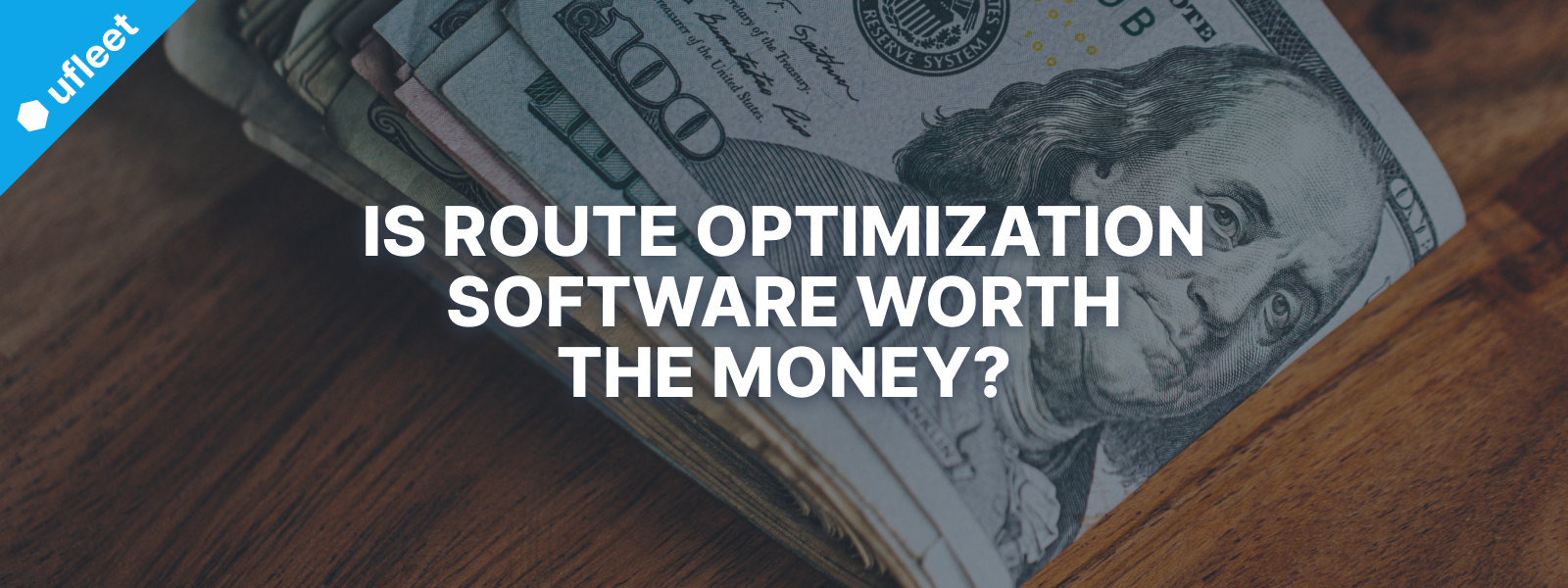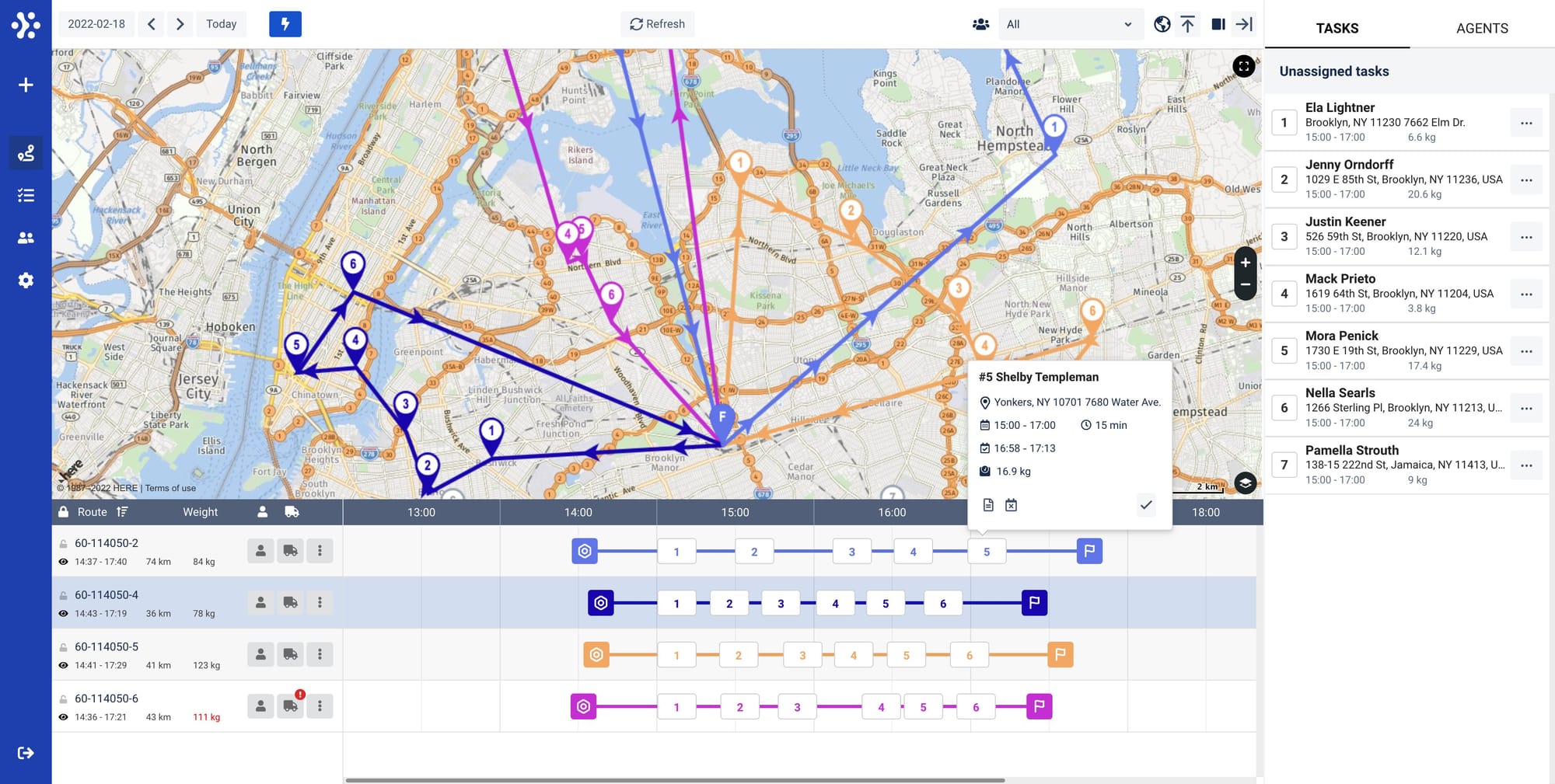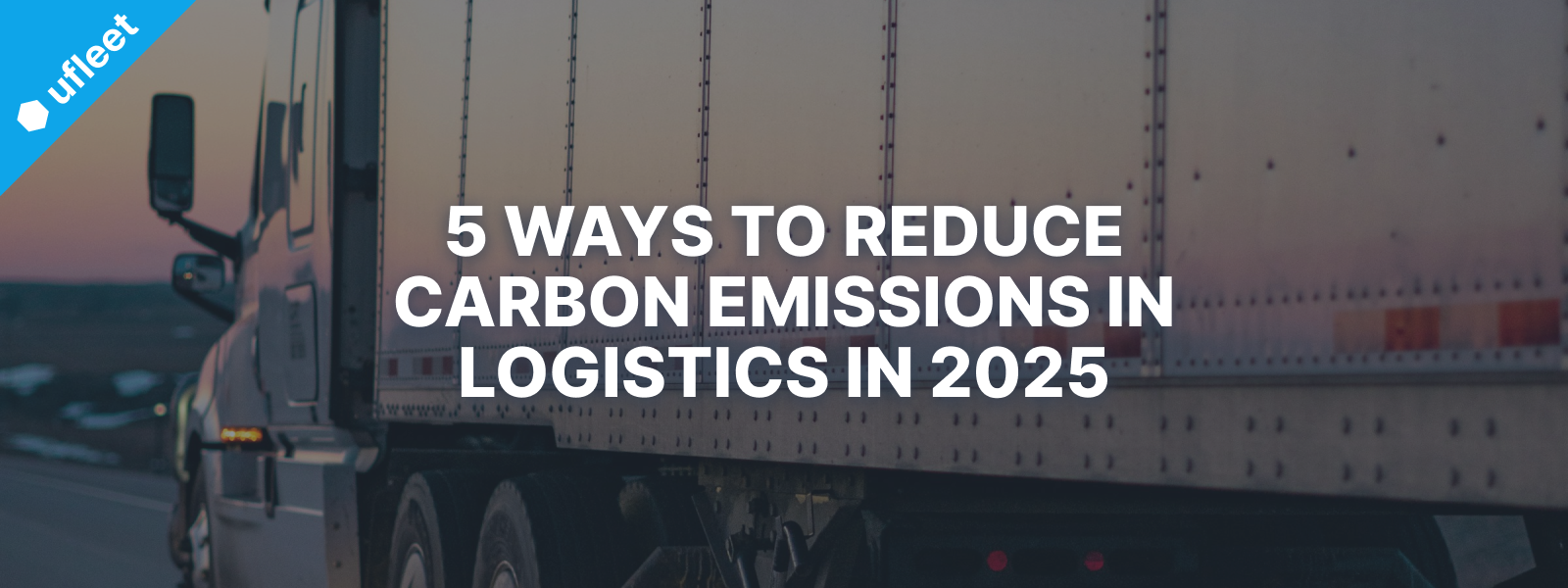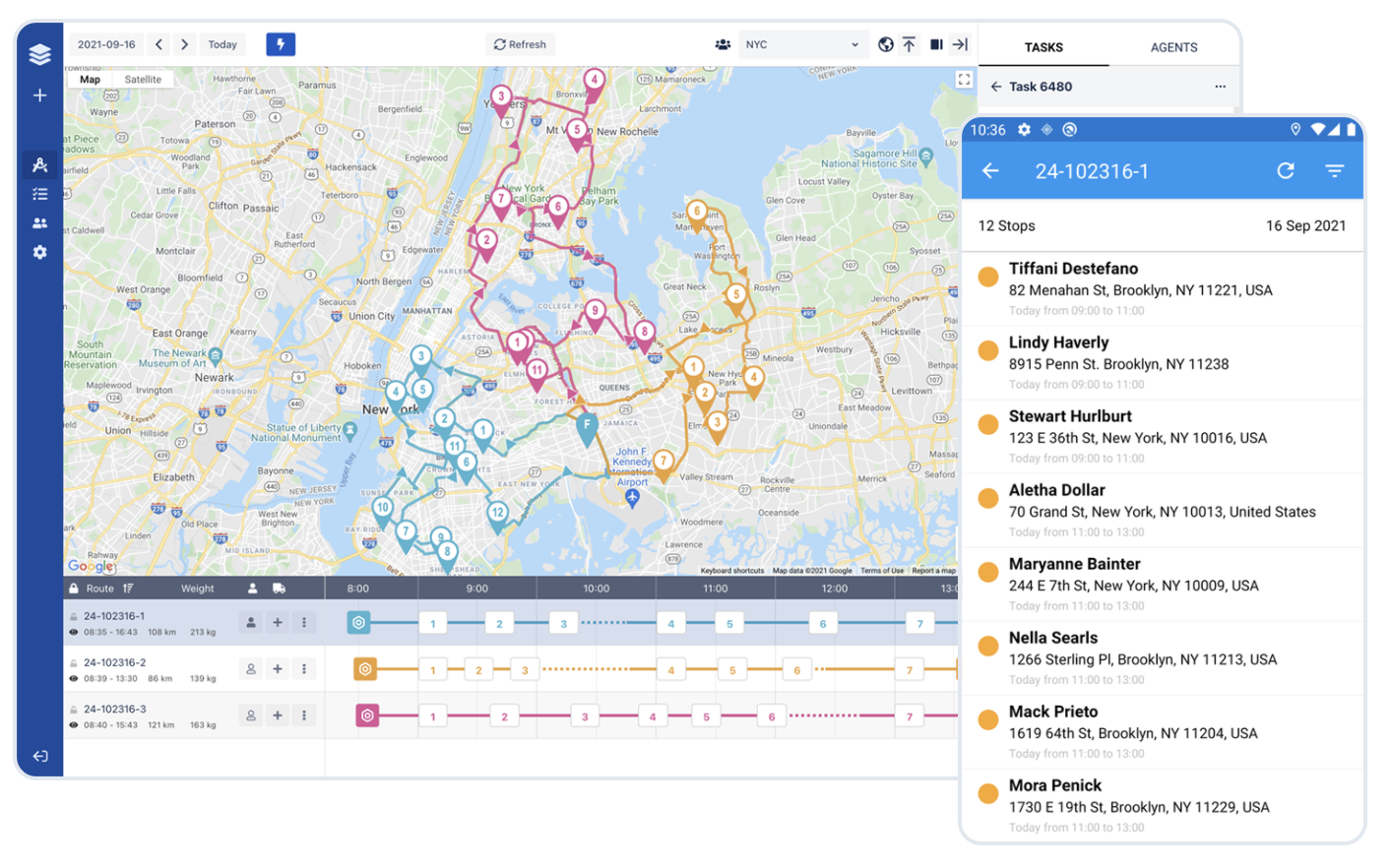Calculating the ROI of route optimization software is key to understanding its value to your business and whether the investment is worth it.

In an era where every second in deliveries counts and customer expectations are higher than ever, route optimization software can make or break your delivery process.
Yet, the decision to invest in such technology goes beyond meeting basic operational needs. It’s also a strategic move towards customer loyalty, sustainability, and long-term growth.
But how do you quantify these benefits? Is route optimization software worth the money?
The answer lies in understanding and calculating the Return on Investment (ROI) of route optimization software. This blog post explores everything you need to know to gain this understanding and make the calculations.
Here’s a summary of what you’ll learn:
- How does route optimization software work
- How to prepare for calculating the ROI
- How to calculate the ROI of route optimization software
- How to maximize the ROI of route optimization software
- How to choose the right route optimization software
- How Ufleet can bring you even greater ROI
Let’s dive in!
How does route optimization software work
Route optimization software determines the most efficient routes for a series of deliveries. You can also find it under the following names: delivery management system, route planning software, and last mile delivery software.
Unlike standard GPS navigation systems, which only provide point-to-point directions, route optimization systems consider various factors, including delivery time windows, vehicle capacity, customer priority, weight, volume, etc.
The process involves several steps:
- Data input: You enter key details such as delivery locations, time windows, vehicle types, and load capacities into the system.
- Optimization: The system generates the optimal route for each vehicle based on the data.
- Execution: Drivers receive their optimized routes via a mobile app, which provides turn-by-turn navigation.
Route optimization software brings numerous benefits to businesses. The most important are reduced delivery costs, increased delivery capacity, and improved customer satisfaction.

How to prepare for calculating the ROI
Calculating the ROI of route optimization software is essential for understanding its value to your business. But to make it right, you need to do some homework first. The process includes several steps:
Step 1: Identify and understand your costs
With the last mile being the most expensive delivery stage, you need to clearly understand the elements that form these costs. These typically are:
- Fleet costs: This includes leasing, insurance, and maintenance of your delivery vehicles.
- Fuel costs: These costs directly correlate to mileage, fuel consumption, and fuel prices.
- Salaries: This includes drivers and office staff such as dispatchers, customer service agents, etc.
A few extra notes to keep in mind here:
- While a part of these costs are fixed (like salaries, insurance, leasing), others can fluctuate (fuel consumption, fuel prices, mileage).
- You might experience seasonal fluctuations in delivery volumes, which can significantly impact costs.
- Handling returns and missed deliveries creates additional costs such as extra fuel consumption and labor hours.
Pro tip: Calculate your average cost of delivery
The average cost of delivery (also called cost to serve) gives a decent indication of how you can price a delivery to a client. It also indicates if your margins can afford free deliveries. More sophisticated last mile software solutions like Ufleet can even give you an exact calculation of these costs and even the cost to serve for each individual delivery.
Step 2: Get to know the potential savings
The potential savings from implementing a delivery management system can be significant. Knowing how much you can save will help you set realistic expectations. It will also help you base your investment decision on solid calculations and not on a gut feeling.
Here's a breakdown of the key areas where savings can materialize:
- Up to 70% in route planning: Automated route planning is where route optimization software has the biggest impact — it turns hours of dispatching work into minutes with far superior route quality.
- Up to 20% in mileage and driver time: Route optimization results in more direct routes, reducing unnecessary mileage and driver time. Savings in mileage also directly impact fuel consumption and vehicle wear.
- Up to 10% in driver behavior: With optimized routes, drivers can complete more deliveries in less time. In addition, real-time tracking prevents irresponsible driver behavior and unnecessary idle time. This translates into up to 10% less mileage and driver time.
- Up to 20% in communication:. Drivers and dispatchers can spend much less time on the phone. This is due to the real-time updates and better planning that last mile software provides.
- Up to 10% in loading time: By scheduling deliveries more efficiently, you can achieve less congested loading docks and speed up the departure process.
- Up to 20% in administration: The automation of route planning and the availability of digital records streamline administrative tasks related to scheduling and tracking deliveries.
Important note: The exact amount of savings will vary based on the volume of your deliveries, current inefficiencies, and how effectively you implement and use the route optimization software. With strategic implementation and ongoing management, the potential for significant cost reductions across these areas is considerable.
Step 3: Set the expectations for your business right
Having a breakdown of potential savings is great, but how do you know if you’ll save 5% or 20%?
It depends, as delivery businesses are diverse. The general rule is:
- the less efficient process you have, the higher the percentage of savings you get
- the bigger the business, the higher the amount of money you save (a large business with tens of thousands of deliveries per month making a 3% saving brings back a lot of cash).
From our experience based on powering tens of millions of deliveries, we see 3 distinct groups according to size and route planning approach:
- Small business / 10s of deliveries per day / Pen and paper planning
- Medium business / 100s of deliveries per day / Google Maps planning
- Large business / 1000s of deliveries per day / Route optimization software
Each of them can expect the following savings on average:
- Small businesses: If you’re a small business still doing pen-and-paper planning, you are literally throwing money away. In your case, a route optimization system can save you around 20% (or even more).
- Mid-size businesses: If you are a mid-sized business using Google Maps or another free tool, professional route optimization software can save you around 15-20%. Even for a couple of vehicles, this can go over $1,000/month.
- Large businesses: If you are a large business operating more than 50 vehicles (in-house or outsourced), there's a huge chance the process you have is efficient. However, at this scale, even 1% optimization in any part of the delivery chain can save you thousands per month so it’s always a good idea to try to improve.
How to calculate the ROI of route optimization software
Do the math of ROI
Return on investment is usually done on an annual basis. The formula to calculate the ROI of your delivery management system investment is:
Keep in mind that the annual software cost is usually subscription-based (monthly or annual).
You can also calculate the breakeven point of your investment. The breakeven point is the moment your savings exceed your investment. It usually takes 6-9 months depending on the specifics of the business but can exceed 2 years for enterprise-scale operations.
ROI calculation example
A company named Fresh Delivery Solutions delivers groceries to New York tri-state area. It has the following parameters*.
*For clarity of the blog post, we provide the most important parameters only. In the calculations that follow, however, we took into consideration many other parameters such as miles per gallon, price per gallon, truck costs per year, cost per mile, cost per delivery, working hours per day, etc.
**Pay rate is based on the salary data for the United States by Indeed
Here’s what their route optimization software setup costs would look like:
And here’s an example of their estimated annual savings. The estimation is based on the business size, volume of delivery operations, and the provided parameters.
So the ROI of this business is calculated as follows:
Consider the intangible benefits
While some benefits of route optimization software are directly quantifiable, such as fuel and time savings, others might be more intangible but equally important:
- Modern and tech-enabled business: This signals to customers and partners that your business is forward-thinking, professional, innovative, and capable of meeting the demands of today's fast-paced environment. A modern, technology-driven workplace is also more attractive to job candidates.
- Improved customer satisfaction: Accurate delivery windows and fewer delays lead to happier customers and increased loyalty. Collecting customer feedback helps you know when your customers are (not) happy and why. The real-time updates, on the other hand, allow you to act timely in case of delays or other issues. Here's a case study to illustrate what we mean.
- Employee satisfaction: Route optimization software reduces stress and leads to more manageable workloads for your drivers and dispatchers. Also, it helps with making your drivers more responsible and accountable.
- Data-driven operations: Data helps you understand your business and costs better, identify areas for improvement, and make informed decisions about your delivery strategy. Ultimately, this allows you to scale your business.
- Reduced CO2 emissions: This helps you achieve more sustainable delivery operations and attract eco-conscious customers and partners. It enhances your brand's reputation and helps you make your business compliant with environmental regulations.
How to maximize the ROI of route optimization software
Buying and implementing a delivery management system doesn’t automatically ensure a high ROI. You have control over how much you can squeeze out of the software. Here’s some general advice:
- Get to know the software's capabilities: Surprisingly, many users are unaware of the full capabilities of the software they’re using. This can lead to huge missed opportunities for efficiency. You need to know the platform inside out to make the most out of it. Explore it at your own pace or even better - ask the vendor to show you around a few times.
- Train your team well: Ensure that all users, from dispatchers to drivers, are well-trained on the software's features and best practices. Regular training sessions can help uncover and address knowledge gaps. This will help your team to leverage the software to its fullest potential.
- Audit your processes: Regular audits of your processes, ideally once or twice a year, are key to maximizing your ROI. This practice helps you stay aligned with the best operational strategies and adapt to changing needs. Keep in mind what worked in the past might not yield the same results today.
- Consider user feedback: Collecting feedback from those who interact with the software daily — drivers, dispatchers, and customers — provides direct insights into its functionality and areas for improvement. Their firsthand experience is invaluable for fine-tuning your delivery operations.
- Stay up to date: Make sure the system you’re using is technologically advanced. There has been a lot of development in the field in the last 5 years, especially with the introduction of AI. If your system is more than 5 years old and has not introduced significant improvements, you might want to reevaluate it.
- Leverage analytics: Most modern delivery management systems include analytics modules designed to offer deeper operational insights. Don’t underestimate them! The analytics functionality helps you discover potential issues and areas where processes may be underperforming. Use these insights to clean and improve your processes.
How to choose the right route optimization software
The right route optimization software will skyrocket your business. The wrong one will rather lead to extra operational struggles and limited savings.
Which one is right for you depends on many factors such as your business model, delivery volume, expansion plans, etc. We explored this topic in detail in this guide to choosing route optimization software — we highly recommend you check it out.
If you’re looking for some quick tips though, here’s some general advice:
- Prioritize your challenges
- Define your goals and objectives
- Take your growth plans into consideration
- Identify must-have and nice-to-have features
- Make sure the vendor has a decent onboarding process
- Take into consideration the support availability
- Be prepared for the demo with questions and use cases you want to see
- Take full advantage of the trial (and don’t leave it for the last moment)
- Set a timeframe to make a decision and try to stick to it
- Approach pricing comparison mindfully to avoid comparing apples to oranges
How Ufleet can bring you great ROI
Ufleet is an AI-powered delivery management system. We've been helping businesses to reduce delivery costs, improve operational efficiency,, and delight customers since 2016.
We are a distributed team of experts in retail, logistics, and technology who are passionate about data and algorithms — that's why we invested tons of effort into perfecting the route optimization functionality of our platform.
Customer centricity, flexibility,, and agile approach are also essential to us. We know every delivery operation is unique in some way, so we always try to step in your shoes.
If you want to learn how we can support your business, get in touch or watch the video below.
FAQ
🚚 What is ROI in the context of route optimization software?
ROI stands for Return on Investment. It measures the cost-effectiveness of route optimization software by comparing the financial benefits gained to the amount spent on its implementation.
🚚 What costs are involved in implementing the system?
Costs include the software subscription, potential implementation consultant costs, and mobile devices for the drivers.
🚚 How soon after the implementation can I see ROI?
It usually takes 6-9 months depending on the specifics of your business and the speed and quality of adoption. However, it can exceed 2 years for enterprise-scale operations.
🚚 Is it difficult to calculate the ROI of route optimization software?
Calculating the ROI of delivery management systems is pretty straightforward. You need to analyze your current costs against the investment cost.
🚚 Does the size of my fleet affect the potential ROI?
Yes, larger fleets often see more significant absolute savings, but small to medium-sized fleets can achieve a higher percentage of cost reduction relative to their size.
🚚 Can I calculate ROI from route optimization software without precise data?
Accurate calculations require specific data, but estimations can be made using average savings and industry benchmarks.
If you found this post helpful, subscribe below to receive similar insights straight in your inbox.❤️✉️
Never miss a post
You may also like…
 Tips & Know-How5 Ways to Reduce Carbon Emissions in Logistics in 2025
Tips & Know-How5 Ways to Reduce Carbon Emissions in Logistics in 2025You too can reduce costs and improve efficiency with Ufleet
- plan and optimize delivery routes
- manage and empower drivers
- enhance customer experience
- make data-driven business decisions
We’d love to learn about your challenges.
Leave your email and we’ll get back to you.

